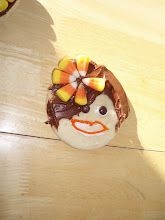 Ever since that first cup of coffee with dates on the airplane, I have been thinking about making my own Arabic coffee, or qahwa/kawah arabeeya. The scent is incredible and the flavor is amazing. I've tasted several versions of qahwa arabeeya while on the ground in KSA and it was all tasted in one day. My first taste was at a colleague's home. His wife poured us small cups of the greenish colored liquid. It was thick and flavorful, just like the coffee I had on the plane. To accompany the coffee, we had dates that were covered with sesame seeds and stuffed with almonds. Later that evening, I went to a park where my colleague's wife was meeting her family for a picnic. As you can see, there were no shortage of beverages. I believe I missed one urn in this photograph, as I can only count seven and I believe every family that came to the picnic brought two urns each - one for the kawah and one for the shai (tea). The slight differentiations in each family's kawah was subtle to my untrained palette, and I was more than happy to continuously try the different varieties that was offered to me.
Ever since that first cup of coffee with dates on the airplane, I have been thinking about making my own Arabic coffee, or qahwa/kawah arabeeya. The scent is incredible and the flavor is amazing. I've tasted several versions of qahwa arabeeya while on the ground in KSA and it was all tasted in one day. My first taste was at a colleague's home. His wife poured us small cups of the greenish colored liquid. It was thick and flavorful, just like the coffee I had on the plane. To accompany the coffee, we had dates that were covered with sesame seeds and stuffed with almonds. Later that evening, I went to a park where my colleague's wife was meeting her family for a picnic. As you can see, there were no shortage of beverages. I believe I missed one urn in this photograph, as I can only count seven and I believe every family that came to the picnic brought two urns each - one for the kawah and one for the shai (tea). The slight differentiations in each family's kawah was subtle to my untrained palette, and I was more than happy to continuously try the different varieties that was offered to me.At work, I have been strictly drinking coffee from Dr. Cafe (see the "Recnetly Dined At" sidebar). It is your typical, western style coffee shop that serves espresso based drinks and American style coffee. I have a cup every morning of the workweek, Saturday to Wednesday, bringing my favorite thermos to get filled.
Today, I went to the grocer and decided that I must try my hand at ARabic coffee. At the spice section there are two types of beans you can order - Arabic and Turkish. I ordered up some Arabic coffee, which I had the spice guy grind for me since I do not yet have my personal coffee grinder. I also purchased some cardamom seed pods, having the choice of two different varieties. I choose the less expensive of the two. The spice guy offered to grind the pods, but I decided to leave them whole.
My unofficial guide to making Arabic coffee:
- Boil water
- Add Arabic coffee and cardamom seeds - they can be ground or you can open up the pods and put the shells and small seeds in together. One internet resource suggests a 2-part coffee to 1-part cardamom ratio.
- Boil together for 5 minutes or so
- Pour and add sweetener if you choose. I neglected to buy sugar, so I added a bit of honey











